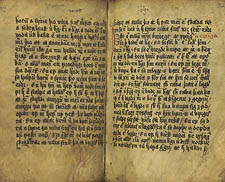Icelandic Jónsbók
![]()
Printing and paper came relatively late to Iceland, home of the medieval
sagas, on the periphery of northwestern Europe. Although a printing press
was active on the island for a few years during the 1530s, demand for
legal and other documents occupied copyists using medieval scripts and
rubrication on domestically produced parchment. Thus despite its late
date (ca. 1550, around the time of the Lutheran Reformation in Iceland),
this copy of Jónsbók--Iceland’s law code, in
force from the late 13th through the end of the 17th century--is essentially
a medieval manuscript.
![]()
Jónsbók. Iceland, fifteenth century.
![]()

Copyright
© 2002 Division of Rare & Manuscript
Collections
2B Carl A. Kroch Library, Cornell University, Ithaca, NY, 14853
Phone Number: (607) 255-3530. Fax Number: (607) 255-9524
For
reference questions, send mail to:
rareref@cornell.edu
If you have questions or comments about the site, send mail to: webmaster.
